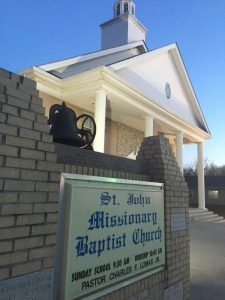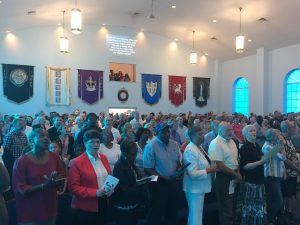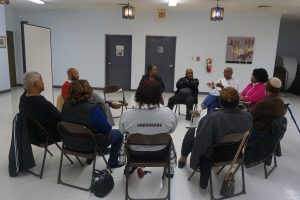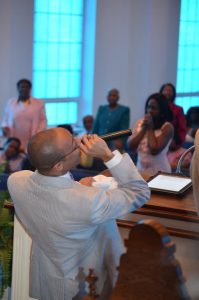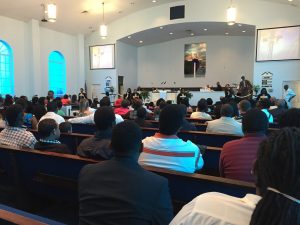The Church In Crisis
I was excited! After having endured the gauntlet of a process that only a Baptist church pulpit committee can concoct, I emerged from approximately 60 other candidates to be called as the twelfth pastor of St. John Missionary Baptist Church in Alcoa, Tennessee.
Not far removed from seminary, I was anxious to accept my assignment and to engage the congregation and the community. With the right amount of energy, enthusiasm, and naiveté I assumed my first pastorate with hopes of impacting the world from the middle of small town Tennessee.
My excitement and energy would soon evaporate as reality and I experienced an unpleasant encounter. At 29 years of age I was pastoring a beautiful, historic church comprised of accepting and kind individuals, but something was amiss. I couldn’t quite put my finger on it. Everything was in place yet simultaneously out of place. It would hit me like the proverbial ton of bricks; I was pastoring a church in the midst of a crisis. And not only was I pastoring a church in the midst of crisis, but the weight of that crisis was beginning to bear down upon my narrow shoulders. By the time I realized it, significant damage had already been done but I was hopeful that we as a congregation could begin the healing process and focus on the matters that needed our attention most.
Crises are not unique to any one religion or to any one denomination. Unfortunately, the ubiquitous nature of crisis is a cohesive connector that breaches doctrinal demarcations. Crisis can assume a multitude of forms: a pastor’s death, an active shooter, pastoral indiscretions, embezzled finances, a dwindling membership, natural disasters, theological disagreements, among others. Each of these, while presenting different challenges, has the potential to irreparably impair an otherwise healthy congregation. According to Edwin Friedman, “Living with crisis is a major part of leaders’ lives.”1 Because conflict and crisis are inevitable, even within the Christian sphere, a strategy to contend with them is necessary if the church is to function effectively.
In the interest of full disclosure, I was aware that St. John had experienced a traumatic episode but I was oblivious as to the specifics or the lingering affects of the trauma. I definitely didn’t surmise that some six years later I would be writing a blog about the experience in partial fulfillment for my Doctor of Ministry degree. Although I knew in part what had transpired, it would actually be years before I would know the story in its entirety because those who experienced the hurt attempted to ignore the hurt away.
The specific details of the crisis I inherited, while scandalous, are not of significant importance. What is important is that while undergoing the practice of pastoral ethnography I discovered that this church was not unfamiliar with crisis. Not just my predecessor, but also the two pastors before him departed the pastorate in a dramatic or traumatic fashion that ultimately left the church in a state of mourning and in need of recovery.
Upon each pastor’s traumatic departure, it became the responsibility of the succeeding pastor to regain momentum and to lead the congregation back to the place of prominence it previously held. Very little external work was being done because all the attention and resources were inwardly focused on healing. While they may be engaging in ministry work, those congregations who are inwardly focused are not fully participating in the missional work of the church. This cycle, reminiscent of a generational curse, has haunted this congregation for at least 70 years. These unfortunate episodes have become anchors tied to the rising potential of a congregation desiring to move forward. Although St. John is still standing, and by some standards improving, these experiences have not occurred without consequence.
Why Collective Vision and How does it Heal?
This project is powered by a pair of principal objectives: collective vision and communal healing. Communal healing is the end while collective vision is the means to that end.
The uniqueness of this work is that it is not simply focused on vision in and of itself, but is concerned with a collective vision birthed of the congregation as a whole. Traditional perceptions of vision are rooted in a leader-follower format, where by a lone leader sets the organizational trajectory, and everyone falls in line with that vision. I opted to seek a collective vision, because the congregation was ailing as a whole. It seemed both fitting and proper to involve the collective group in reaching a collective solution. I had no desire to play the role of the cape-adorned superhero that was swooping in to save the day; therefore, a collective endeavor was the only viable option to secure communal healing.
For decades, churches and parachurch organizations around the world have been concerned with crafting a cohesive vision to offer focus to their congregations and those who partner with them in the work they strive to do. As chic as vision statements have become, vision is not an innovation of modernistic thought but is as old as creation itself. Linda L. Clader in her book Voicing the Vision emphasizes that although the biblical text does not consistently and explicitly use the language of vision, that vision has its origins in the stories of the patriarchs.2 Abram in Genesis 15; Jacob in Genesis 28; and the great prophets including Isaiah, Jeremiah, and Ezekiel were all recipients of visions. Clader also notes that Biblical visions were experiences of sight and sound.3 Visions are as important now as they were then, and visions are a vital part of capturing the imaginations and the hopes of those who are the recipients and benefactors of the vision.
Many have offered their perspectives as to what vision is and what it does. Aubrey Malphurs defines vision as “a clear, exciting picture of the future of a ministry, such as a church, that God uses to motivate that ministry to accomplish its mission.”4 Malphurs and Gordon E. Penfold note that vision “is a clear, exciting picture of God’s future for your ministry as you believe it can and must be.”5 Andy Stanley posits, “Vision is a clear mental picture of what could be, fueled by the conviction that it should be.”6 Lovett H. Weems, Jr., states, “It is a dream. It is a picture of what is possible. Perhaps the best way to think of it is a picture of a preferred future.”7 The common thread among these perspectives is that vision is discernible and looks ahead.
The healing piece is not as clear-cut as the vision piece. Healing is extremely subjective which is why for the purpose of this project, it is being treated as progression from paralysis provoked by the crisis. Though the congregation did not play a substantial role in precipitating the crisis, they can play a pivotal role in the recovery. In his classic, The Wounded Healer, Henry Nouwen raises the question “How does healing take place?” He answers that question with one word: hospitality8
Healing, I believe, can be found in community, where there is the potential for problems to become possibilities. Nouwen writes, “A Christian community is therefore a healing community not because wounds are cured but because wounds and pains become openings or occasions for a new vision.”9 Wounds confer credibility to crises, but they also possess the capacity to initiate vision. New vision is the prescription for communal healing.
Reflections on the Research
The intricate nature of this project’s aims necessitated a multifaceted stream of data collection. This work used one-on-one interviews, focus groups, and a survey to acquire both qualitative and quantitative data. From the information collected, foundational elements were acquired to begin implementing the collective vision for St. John’s future. Additionally, these sessions also provided an occasion to engage in the practice of pastoral care which was something much needed within the congregation.
Interviews
The first phase of data collection involved one-on-one interviews. Under the agreement of anonymity, I sat individually with ten longstanding members of the church to gain perspective of the church’s history as well as the crises encountered during their tenures. While of couple of the respondents were extremely guarded in their answers, the rest did not mind sharing their thoughts and perspectives in response to my questions. Those that were comfortable were extremely candid and provided excellent feedback as to what had transpired prior to my arrival as pastor. This was beyond beneficial because until this point, I never had a clear understanding as to the events that precipitated the crisis or the timeline that accompanied said events. I was able to piece together from each of their vantage points what took place and what led to my becoming pastor of the church.
Focus Groups
After having conducted interviews with longstanding members, the second phase of research was open to all willing participants. Members of St. John had the opportunity to signup for one of four focus groups that would be taking place over a two-day period during the month of November.
Each focus group consisted of no more than 10 individuals and focused on the possibilities within the congregation over the problems within the congregation. Participants discussed their perceptions of the church’s purpose, what they saw as being special about St. John, the unique needs of the immediate community, and their excitement about and hopes for the church’s future. This method of research gathering provided vast amounts of qualitative data.
At the beginning of each gathering, prayer was offered followed by an attentive practice created to remind those assembled of our congregational identity as well as the legacy being preserved for future generations. Joshua 4:1-9 was the meditative scripture and the practice centered on the stones around the main entrance of the otherwise all-brick church. When the current edifice was constructed in 1992, the stones that made up the original structure were brought over to be a part of the new building. When people walk into the church, they are led through elements unique to the original church. These stones serve as a reminder of where the church had been as the congregants gathered to determine where the church would go from there.
Survey
With the qualitative data gathered during the focus groups, a survey was constructed to refine and enhance the information that had been collected. The rationale behind the survey was to categorize the importance of what had previously been shared in the focus groups to add a quantitative component to the research. The survey did not deviate from the focus groups, but rather was used to subcategorize the larger themes addressed during the month long focus group process. This survey amalgamated the thoughts of the individual focus groups into a single space that provided a launching pad for the entire congregation to address relevant issues.
Congregants age 16 and above were invited to fill out the survey. Sixty-six respondents completed and returned the survey. Although containing only six questions, the survey afforded respondents the opportunity to select multiple boxes to answer certain questions. The results were beneficial in helping discover our congregation’s major concerns and ministry passions. As the data highlights, respondents believe the church should be most involved in job mentoring and training. The data also indicated that congregants are most concerned about drugs in the community and are most excited about receiving God’s Word through sermonic form.
Well That’s Interesting
Looking at the data collected and the streams of research that were employed, there were a few things that gave me pause and prompted me to think, “well that’s interesting!”
I found it interesting that our congregation is divided as to whether or not we have completely healed from the most recent crisis experienced in the church. This finding was initially discovered during the interview portion of data collection when I explicitly asked participants, “Do you believe that the church has fully recovered from the crisis?” Out of the ten respondents, five replied “yes” and five replied “no.” Such a divided split informs me that there is still work to be done in the area of communal healing.
The focus groups were telling and provided moments of clarity and interest. It was interesting to observe the groups and see who spoke the most, but also who remained quiet. It was also interesting to hear many of the concerns of the members that had never been voiced before…at least not to me.
The surveys also provided “well that’s interesting!” moments. I was surprised at the number of individuals who selected “The Preaching” as what most excites them about being a part of St. John Missionary Baptist Church.
Unrelated to the members selecting “The Preaching” as what excites them most, the art of preaching was selected as the innovative tool to disseminate the collective vision of the church. Sunday mornings are when the largest concentration of individuals are gathered, so it made sense to use preaching to share the vision and the direction in which we are heading.
Where Do We Go From Here?
There are so many ways to answer this question because, at the risk of sounding cliché, the possibilities are endless. The members of St. John Missionary Baptist Church have demonstrated time and time again that they possess an unparalleled resolve that enables them to persevere when others would have readily surrendered to the circumstances. This congregation possesses the desire to thrive and to meet the needs of those around them; that desire simply has to be coupled with effort and the expertise.
As we pave the way forward, we have constituted a vision team consisting of members of the church who are charged with the task of leading the congregation in the process of forming and implementing the communal vision. This team represents the diversity of our church, and is tasked with giving shape to the data already collected as well as any other additional steps they deem necessary as we move ahead. The team will meet on a bi-monthly basis, and will ascertain how we best clarify our vision and how we put that vision into practice.
Additionally, preaching will continue to be a critical component to the church’s healing and growth. Sermons that speak to the newly formulated vision and the matters most significant to the congregation will be offered in sermonic form in an effort to meet the people at the point of their needs. The vision will inform the sermons, and the sermons will project the objectives of the vision. Multiple sermon series were constructed last year prior to the data collection to inform the congregation of vision, healing and other key components of this project. Those efforts will be continued and will shift depending on the concerns of the congregation.
Unfortunately, St. John is not the only church that has ever had to endure crisis and I’m afraid that it will not be the last. This process was designed specifically for St. John Missionary Baptist Church; however, if it would be of benefit to other congregations I would encourage making the effort to engage in a collective visioning process.
No one individual has all the answers, and there is strength in the unity of the body.
Wherever we go from here we will go together, as we strive to be the church that God is calling us to be. Alcoa needs St. John Missionary Baptist Church. The world cannot afford for our churches to be lost within themselves. Crises may come, but we have a mission to fulfill and to fulfill that mission we must have vision.
Vision is good, but collective vision is better! Collective vision is a gateway toward an intentional future, and it introduces the idea of possibility among us. Collective vision, beyond it’s communal property, will initiate the healing process and ultimately serve as the catalyst for the change we are desiring to see. With all of this accomplished, the collective vision will also have proved vital to the fulfilling of God’s mission. As we press toward communal healing, collective vision is that thing which will get us there.
Footnotes
1Edwin H. Friedman, A Failure of Nerve: Leadership in the Age of the Quick Fix (New York, NY: Seabury Books, 2007), 27.
2Linda L Clader, Voicing the Vision: Imagination and Prophetic Preaching (Harrisburg, PA: Morehouse Publishing, 2004), 27.
3Ibid., 28.
4Aubrey Malphurs, Developing a Vision for Ministry, Third ed. (Grand Rapids, MI: Baker Books, a division of Baker Publishing Group, 2015), 34.
5Aubrey Malphurs and Gordon E. Penfold, Re:Vision: The Key to Transforming Your Church (Grand Rapids, MI: Baker Books, a division of Baker Publishing Group, 2014), 154.
6Andy Stanley, Visioneering: God’s Blueprint for Developing and Maintaining Vision (Colorado Springs, CO: Multnomah Books, 1999), 18.
7Lovett H. Weems Jr., Church Leadership: Vision, Team, Culture, and Integrity, Revised ed. (Nashville, TN: Abingdon Press, 2010), 23.
8Henri J. M. Nouwen, The Wounded Healer: Ministry in Contemporary Society, 1st Image ed. (New York, NY: Image Books, 1990), 89–90.
9Ibid., 94.

